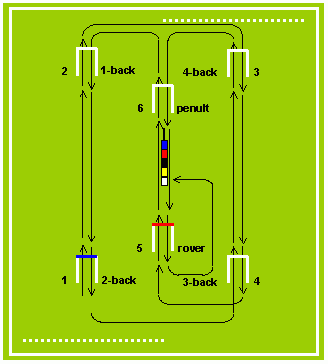 The objective
The objective
A full-size croquet court measures 35 x 28 yards and has six hoops and the
peg set out as illustrated. In a singles game each player uses a mallet to hit
two balls through 12 hoops in the order shown. The hoops are only 1/16th or
1/8th of an inch wider than the balls. Six hoops numbered 1-6 are 'run'
clockwise and six anti-clockwise, known as 1-back, 2-back, 3-back, 4-back,
'penult' and 'rover'. The balls are then hit against the peg ('pegging out').
The winner is the first player to 'peg out' both balls for a total of 26 points
(1 point each for 12 hoops + 1 for peg = 13, for each of 2 balls = 26).
The Red and Yellow balls are played against Blue and Black, but you may also
see Pink and White played against Green and Brown. This allows two games to be
played on the same lawn and is confusing for spectators!
The start
The toss of a coin determines choice of colours and who
starts first. All four balls must be used in the first four turns, starting from
either of two lines at the ends of the court, as indicated by the dotted lines.
The basics, and 'making a break'
Players take turns and can play either ball. Imagine
you are playing with Red and Yellow and it is your turn. Firstly you decide
which ball to play your turn with according to which gives you the best chances
for the least risk.
You decide to play Red. Three things can happen:
- If Red does not hit another ball or run a hoop your turn ends and your opponent then has a turn.
- Red runs its next hoop and you get another stroke ('a continuation stroke').
- If Red hits ('roquets') one of the other balls you
get two extra strokes. The first of these is the croquet stroke. You pick up
Red, place it in contact with the ball it hit and play it again so that both
balls move. You then get a continuation stroke which you can use to roquet
another ball, or, if you are in position, run the next hoop and earn another
continuation stroke.
In any turn you can roquet each of the other three balls once between running one hoop and the next.
With the croquet strokes and another continuation stroke this gives you up to
seven strokes before you have to run a hoop or your turn ends. You aim to
use one of the croquet strokes to put your ball in front of its next hoop
and use the continuation stroke to run the hoop. This is shown below:
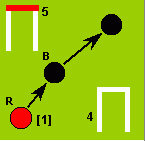 |
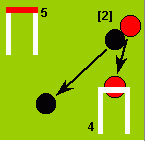 |
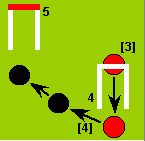 |
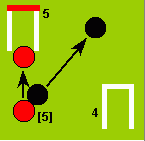 |
| It is Red's turn and Red's next hoop is hoop 4.
Red is played [1] to hit (roquet) Black. Black ends in the position shown
and Red is picked up and placed in contact with Black for the croquet
stroke. |
In the croquet stroke [2] Red is played with the two
balls in contact. Both Red and Black move, Red ending up in front of
hoop 4 and Black to the side. After the croquet stroke Red then has a
continuation stroke. |
In the continuation stroke [3] Red runs hoop 4. As a
result of running the hoop Red gains another continuation stroke. This
stroke [4] is used to roquet Black again, as Red has run a hoop since the
previous roquet. |
Red is placed against Black for the croquet stroke
[5], played to leave Black to one side of hoop 5 and Red in front. Red now
has a continuation stroke (not shown) to run hoop 5 and could then roquet
Black again. |
If Blue (or Yellow) happens to be near Red's next
hoop (hoop 6) Red may be able to use the croquet shot from Black to get close
enough to roquet Blue and then run at least one more hoop in this turn, thus 'making a break'.
A skilled player will try to use all the balls to create a 'four-ball break' in
which roquet and croquet strokes are used to put the balls in useful positions
in the middle of the court and near the next hoop to be run, so that a number of
hoops (sometimes all 12) can be run in a single turn.
As in snooker, a player who cannot make a break will try to leave the balls in a
defensive position, where the opponent cannot make a break, but where the
first player has another chance in his/her next turn should the opponent miss.
This makes the game highly tactical. 'Field snooker' is an apt description
of it.
Some important techniques
| As the two diagrams to the right show, the roquet
stroke can be used to hit the roqueted ball at a desired angle and
the croquet stroke, with two balls, can be aimed to send both balls in desired directions: |
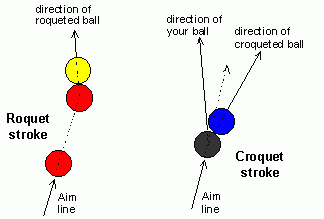
|
| A normal croquet stroke played
along a straight line through the centre of both balls will send the front
ball 3-4 times as far as the back ball. However this can also be varied to
send the balls different relative distances using a roll stroke or stop
shot: |
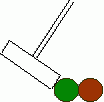 |
Roll stroke
Your ball is hit above centre. Both your ball and the croqueted ball
will travel about the same distance. Your ball may even pass it. |
 |
 |
Stop shot
Hit below centre with no follow through. The croqueted ball will travel 5-7 times further. |
 |
And some important technicalities
There are a lot of technicalities. Some important ones are:
Time limits
A time limit, often 3 hours, may be agreed at the start. If the limit is
reached, the turn in progress and the opponent's next turn are completed and the
player with most points wins.
The boundary line
Balls that go off court are put back one yard into the court.
So are balls that end up less than a yard inside the boundary (with the
exception of a ball that has a continuation stroke). If either ball goes off
from a croquet stroke, the turn ends. A ball is off court if it overlaps the
boundary line.
Peeling
If you are playing a turn with one ball you can score points
for another ball by the first ball hitting the other ball through its next hoop
(known as 'peeling').
Wiring
There are special laws concerning balls hidden behind
hoops or the peg (known as 'wired').
Pegging out
A pegged-out ball is removed from the game. In the
handicap version of the game (see below), a player may not peg either of his/her
balls out until both balls have run rover (the last hoop). If both players have
run a ball through rover, a player may use the 'rover ball' to peg out the
opponent's 'rover ball' and force the opponent to play with one ball, which is
usually a disadvantage. This can give rise to some clever tactics near the end
of the game.
Keeping score
Players keep score with clips, coloured to match the balls. These mark the hoop that the ball has to go through
next. For hoops 1 to 6 clips are placed on the top; for the second 6 they are
placed on the side. Once a player has run a hoop he/she will remove the clip for
that ball. At the end of the turn the clip is placed on the next hoop for that
ball.
Different versions of the game
Doubles play
In doubles play the players work as a pair, each player being allocated one ball for the match. Thus if the
Red and Yellow pair decide to play a turn with Red, that dictates which of the
pair plays the whole turn.
Handicap play
Players have handicaps which can range from minus 3 (best) to 24. In handicap
play the higher handicapped player is entitled to a number of extra turns,
called bisques, equal to the difference in handicap of the two players. Bisques
are counted by sticks stuck in the ground near the court. At the end of a turn a
player with bisques may start another turn with the same ball and a stick is
removed.
Advanced play
In advanced play, used in championship events, players meet on level terms
without bisques. Advanced play also has a few different rules. The main
difference is that after a turn in which a player runs hoop 1-back or 4-back,
his opponent may move one of his balls to either start line for his next turn
for a better chance of starting a new break. To counter this to some extent, top
experts try to use their second ball to peel the first through its last three
hoops and finish the game with a double peg out all in the same turn (known as a
'triple peel').
Association Croquet is the game summarized in this note and played at tournaments and
championships, to either handicap or advanced rules.
Short Croquet is Association Croquet played on a half size lawn. Players run hoops 1 to 6 and
then hit the peg.
Golf Croquet is a popular sequence game of single ball strokes, with no roquet or croquet shots.
Joining a club
There are 200 English clubs affiliated to the Croquet
Association with 5,000 members. If you would like to join a club, details
are on the Croquet Association website.
For information about the Watford (Cassiobury) Croquet Club, explore this
website, speak to one of the players at the club or contact the Club Secretary.
MH
5.7.05
Return to top of page

 Open AC Midweek Advanced
Open AC Midweek Advanced
 Open AC One-Day
Open AC One-Day
 Open AC Midweek B-Level Advanced
Open AC Midweek B-Level Advanced
 AC Level Advanced
AC Level Advanced
 AC B-Level Advanced
AC B-Level Advanced
 AC Handicap
AC Handicap
 AC All England Handicap
AC All England Handicap
 AC High Handicap
AC High Handicap
 AC Charity One-Ball
AC Charity One-Ball
 AC One-Ball (Sep)
AC One-Ball (Sep)
 AC One-Day Doubles (Aug)
AC One-Day Doubles (Aug)
 AC One-Day (Sep)
AC One-Day (Sep)
 Open GC C-Level
Open GC C-Level
 Open GC B-Level
Open GC B-Level
 Open GC Handicap Doubles
Open GC Handicap Doubles
 Open GC A-level
Open GC A-level
 Open GC
Open GC
 GC Level Play
GC Level Play
 EACF GC Club Champions Tournament
EACF GC Club Champions Tournament
 GC Handicap Singles
GC Handicap Singles
 GC All England Handicap
GC All England Handicap
 GC Handicap Doubles
GC Handicap Doubles
 GC Progressive Doubles (Apr)
GC Progressive Doubles (Apr)
 GC Progressive Doubles (Sep)
GC Progressive Doubles (Sep)
 GC Intermediate Handicap
GC Intermediate Handicap
 GC High Handicap
GC High Handicap
 GC Grass Roots
GC Grass Roots







